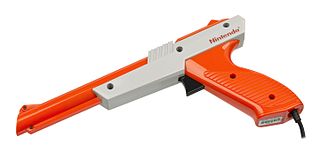
A light gun is a pointing device for computers and a control device for arcade and video games, typically shaped to resemble a pistol.

Breakout is an arcade video game developed and published by Atari, Inc. and released on May 13, 1976. It was designed by Steve Wozniak, based on conceptualization from Nolan Bushnell and Steve Bristow, who were influenced by the seminal 1972 Atari arcade game Pong. In Breakout, a layer of bricks lines the top third of the screen and the goal is to destroy them all by repeatedly bouncing a ball off a paddle into them. The arcade game was released in Japan by Namco. Breakout was a worldwide commercial success, among the top five highest-grossing arcade video games of 1976 in both the United States and Japan and then among the top three highest-grossing arcade video games of 1977 in the US and Japan. The 1978 Atari VCS port uses color graphics instead of a monochrome screen with colored overlay.

Chase H.Q. is a vehicular combat racing game, originally released as an arcade video game by Taito in 1988. It is sometimes seen as a spiritual successor to Taito's earlier Full Throttle. The player assumes the role of a police officer named Tony Gibson, member of the "Chase Special Investigation Department". Along with his partner, Raymond Broady, he must stop fleeing criminals in high-speed pursuits in a black Porsche 928.

Ikari Warriors, known as Ikari in Japan, is a vertically scrolling run and gun video game released for arcades by SNK in 1986. It was published in North America by Tradewest. At the time there were many Commando clones on the market. What distinguished Ikari Warriors were rotary joysticks and a two-player cooperative mode. The rotary joystick controls were in turn based on SNK's earlier TNK III (1985). Ikari was originally intended to be an official licensed adaptation of the film Rambo: First Blood Part II (1985), but SNK were initially unable to acquire the rights to the film.
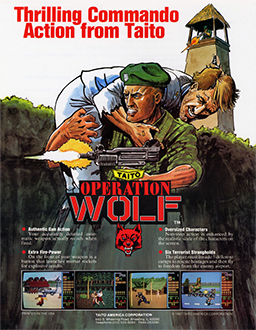
Operation Wolf is a light gun shooter arcade game developed by Taito and released in 1987. It was ported to many home systems.

Tomohiro Nishikado is a Japanese video game developer and engineer. He is the creator of the arcade shoot 'em up game Space Invaders, released to the public in 1978 by the Taito Corporation of Japan, often credited as the first shoot 'em up and for beginning the golden age of arcade video games. Prior to Space Invaders, he also designed other earlier Taito arcade games, including the shooting electro-mechanical games Sky Fighter (1971) and Sky Fighter II, the sports video game TV Basketball in 1974, the vertical scrolling racing video game Speed Race in 1974, the multi-directional shooter Western Gun in 1975, and the first-person combat flight simulator Interceptor (1975).

Gun Fight, known as Western Gun in Japan and Europe, is a 1975 multidirectional shooter arcade video game designed by Tomohiro Nishikado, and released by Taito in Japan and Europe and by Midway in North America. Based around two Old West cowboys armed with revolvers and squaring off in a duel, it was the first video game to depict human-to-human combat. The Midway version was also the first video game to use a microprocessor instead of TTL. The game's concept was adapted from Sega's 1969 arcade electro-mechanical game Gun Fight.
1978 saw the release of new video games such as Space Invaders. The year is considered the beginning of the golden age of arcade video games. The year's highest-grossing video game was Taito's arcade game Space Invaders, while the best-selling home system was the Atari Video Computer System.
1977 had sequels such as Super Speed Race and Datsun 280 ZZZAP as well as several new titles such as Space Wars. The year's highest-grossing arcade games were F-1 and Speed Race DX in Japan, and Sea Wolf and Sprint 2 in the United States. The year's best-selling home system was Nintendo's Color TV-Game, which was only sold in Japan.
1976 had new titles such as Road Race, Night Driver, Heavyweight Champ, Sea Wolf and Breakout. The year's highest-grossing arcade games were Namco's F-1 in Japan and Midway's Sea Wolf in the United States.
1975 had new titles such as Western Gun, Dungeon and dnd. The year's best-selling arcade game was Taito's Speed Race, released as Wheels and Wheels II in North America.
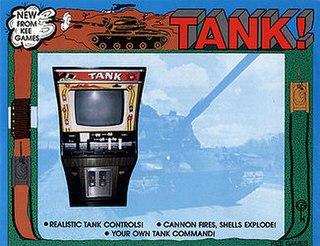
Tank is an arcade game developed by Kee Games, a subsidiary of Atari, and released in November 1974. It was one of the few original titles not based on an existing Atari property developed by Kee Games, which was founded to sell clones of Atari games to distributors as a fake competitor prior to the merger of the two companies. In the game, two players drive tanks through a maze viewed from above while attempting to shoot each other and avoid mines, represented by X marks, in a central minefield. Each player controls their tank with a pair of joysticks, moving them forwards and back to drive, reverse, and steer, and firing shells with a button to attempt to destroy the other tank. The destruction of a tank from a mine or shell earns the opposing player a point, and tanks reappear after being destroyed. The winner is the player with more points when time runs out, with each game typically one or two minutes long.

280 ZZZAP is a racing arcade video game designed by Jamie Fenton for Dave Nutting Associates. Based on Nissan's Datsun 280Z, it is one of the earliest games with authorized branding.
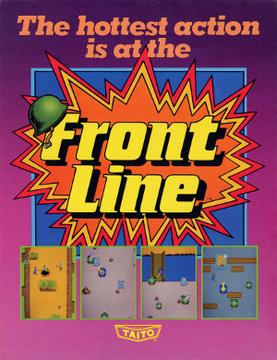
Front Line is a military-themed run and gun video game released by Taito for arcades in November 1982. It was one of the first overhead run and gun games, a precursor to many similarly-themed games of the mid-to-late 1980s. Front Line is controlled with a joystick, a single button, and a rotary dial that can be pushed in like a button. The single button is used to throw grenades and to enter and exit tanks, while the rotary dial aims and fires the player's gun.
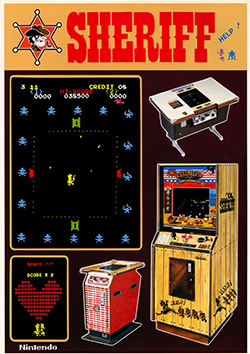
Sheriff, also known as Bandido, is a 1979 multi-directional shooter arcade game by Nintendo. It is one of several Western-themed video games from the 1970s, along with Western Gun, Outlaw, and Boot Hill. The player controls a county sheriff tasked with defense of a town against bandits, to rescue the captured woman. It was a commercial success in Japan, where it was among the top ten highest-grossing arcade games of 1979.

Sea Wolf is an arcade video game designed by Dave Nutting and released by Midway in 1976. It is a video game update of an electro-mechanical Midway game, Sea Devil, itself based on Sega's 1966 electro-mechanical arcade submarine simulator Periscope. The game was released in Japan by Taito. In Sea Wolf, the player, piloting an unseen submarine, launches torpedoes vertically in an attempt to sink ships moving horizontally across the screen before time runs out. The screen is viewed through a faux periscope mounted on the cabinet.

Gun Buster, also known as Gunbuster (ガンバスター) and released in North America as Operation Gunbuster, is a first-person shooter video game developed by Taito and released for arcades in 1992. In contrast to on-rail light gun shooters at the time, this was one of the first arcade games to feature free-roaming FPS gameplay, the same year Wolfenstein 3D was released on personal computers.

Speed Race is a 1974 arcade racing video game developed and manufactured by Taito and released under the titles Racer and Wheels in North America by distributor Midway Manufacturing in 1975. Designed by Tomohiro Nishikado, the gameplay involves the player using the attached steering wheel to maneuver a car alongside a fast vertical scrolling road. The objective is to score points by driving past other cars without colliding with them; more points are awarded for driving faster. Players must do this under a 90-second time limit, which ends the game when it runs out. The gameplay concepts were adapted from two earlier driving electro-mechanical games: Kasco's Mini Drive (1958) and Taito's Super Road 7 (1970).
Electro-mechanical games are types of arcade games that operate on a combination of some electronic circuitry and mechanical actions from the player to move items contained within the game's cabinet. Some of these were early light gun games using light-sensitive sensors on targets to register hits, while others were simulation games such as driving games, combat flight simulators and sports games. EM games were popular in amusement arcades from the late 1940s up until the 1970s, serving as alternatives to pinball machines, which had been stigmatized as games of chance during that period. EM games lost popularity in the 1970s, as arcade video games had emerged to replace them in addition to newer pinball machines designed as games of skill.

LeMans is a single-player race game created by Atari, Inc. in 1976. It was distributed in Japan by Namco. It is the successor to the Gran Trak 10 and Gran Track 20 video games.















